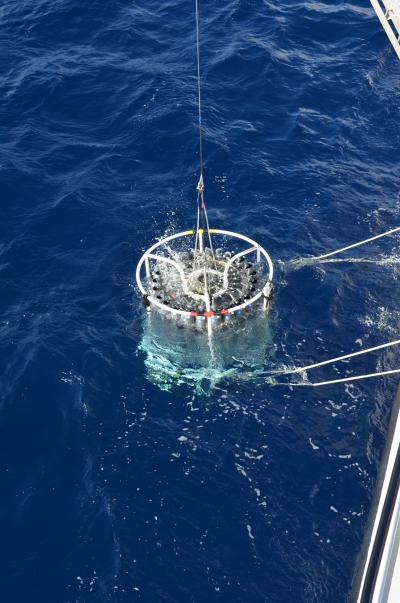Science:海洋细菌性膜囊泡能够影响全球碳循环
美国麻省理工学院的研究人员揭示原绿球藻的细菌性膜囊泡不同功能机理。相关文章发表于2014年1月10日的《science》杂志上。

采集海水样本 图片来源:Steven Biller
原绿球藻——这是海洋中最丰富的蓝细菌——一直在散布大量的含有蛋白质、DNA和RNA的菌“芽”。
Steven Biller及其同事说,这些细菌性膜囊泡可能会对全世界的碳预算产生显著的影响。研究人员对在实验室中生长的原绿球藻的囊泡脱落进行了观察并检测了马萨诸塞州葡萄园海峡(Vineyard Sound)海域及中大西洋马尾藻海的海水中的囊泡的丰度。
他们的数据显示,这种细菌每天所脱落的囊泡有近兆兆之多。这些满载营养的包袱能够支持显著的细菌增长,并因此能够对全球的碳循环造成影响。它们还能作为在海洋生物体间横向基因转移的一种方式,并甚至能作为细菌为了迷惑病毒而抛弃的“诱饵”。David Scanlan对这些不同的作用进行了讨论。
原文摘要:
Bacterial Vesicles in Marine Ecosystems
Steven J. Biller, Florence Schubotz, Sara E. Roggensack, Anne W. Thompson, Roger E. Summons,Sallie W. Chisholm
Many heterotrophic bacteria are known to release extracellular vesicles, facilitating interactions between cells and their environment from a distance. Vesicle production has not been described in photoautotrophs, however, and the prevalence and characteristics of vesicles in natural ecosystems is unknown. Here, we report that cultures of Prochlorococcus, a numerically dominant marine cyanobacterium, continuously release lipid vesicles containing proteins, DNA, and RNA. We also show that vesicles carrying DNA from diverse bacteria are abundant in coastal and open-ocean seawater samples. Prochlorococcus vesicles can support the growth of heterotrophic bacterial cultures, which implicates these structures in marine carbon flux. The ability of vesicles to deliver diverse compounds in discrete packages adds another layer of complexity to the flow of information, energy, and biomolecules in marine microbial communities.
Bacterial Vesicles in the Ocean
David Scanlan
Marine microbes play a key role in global nutrient cycling (1). Phytoplankton account for less than 1% of the photosynthetic biomass on Earth, yet contribute almost half of the world's primary production (2). In open oceans between ∼45°N and ∼40°S, cyanobacteria of the genus Prochlorococcus dominate the phytoplankton (3).Prochlorococcus is the smallest free-living phototroph; its genome is subject to miniaturization (4), and distinct ecotypes are adapted to the strong gradients of light and nutrients in the surface ocean (5). On page 183 of this issue, Biller et al. (6) identify a further striking feature of Prochlorococcus: the production of extracellular vesicles that may play a role in carbon cycling, gene transfer, and viral defense.

